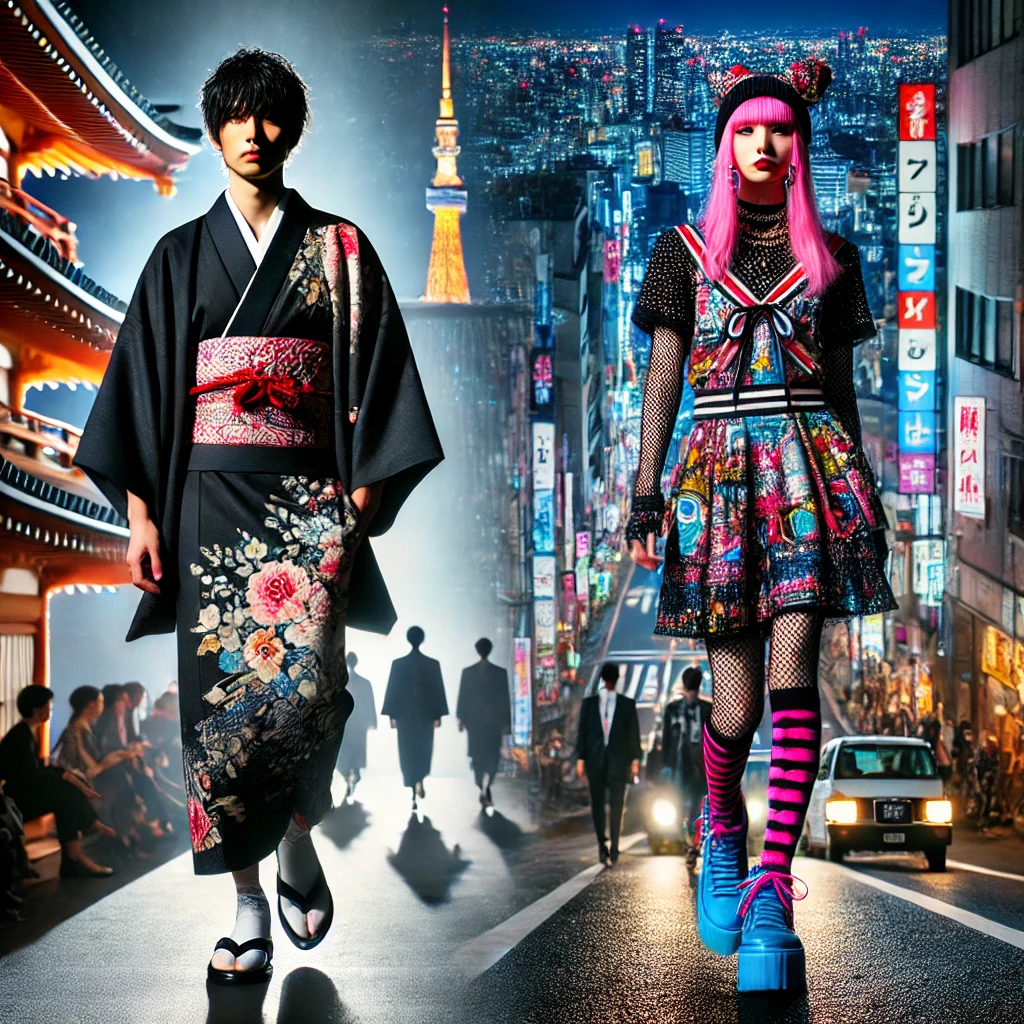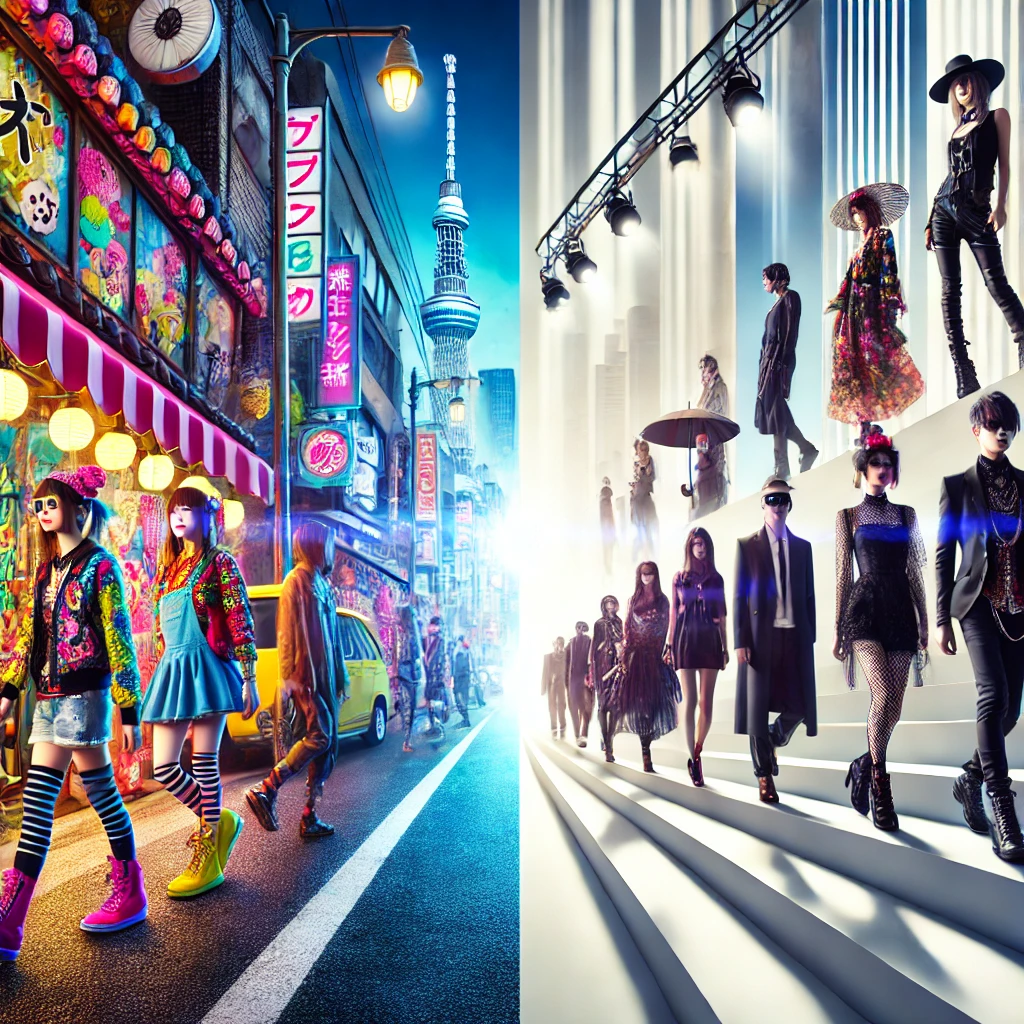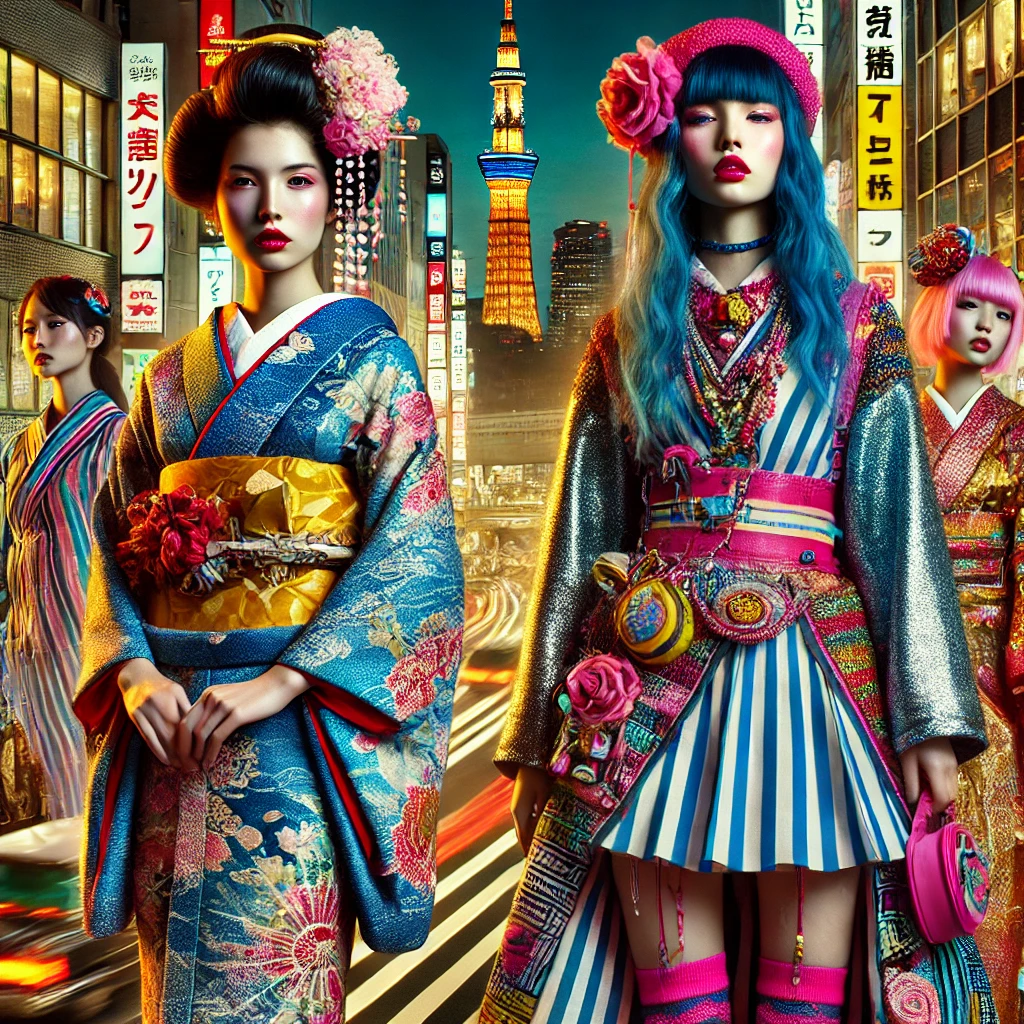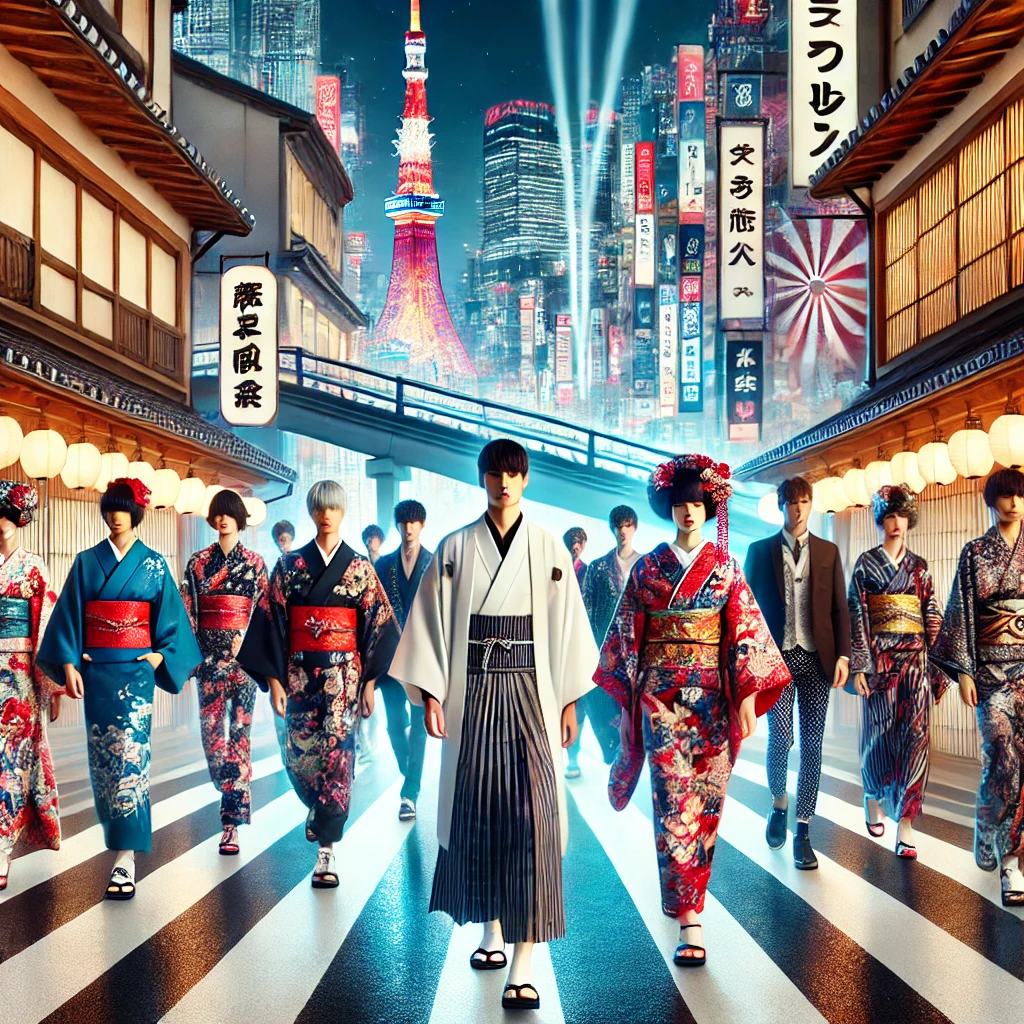Table of Contents
Introduction to Japanese Fashion
Japanese fashion represents a fascinating tapestry woven from various cultural, historical, and social threads. Emerging from a rich heritage, it is characterized by its unique ability to blend the traditional with the contemporary, resulting in styles that are both innovative and deeply rooted in historical significance. From the intricate patterns of kimono fabric to the avant-garde pieces seen on dynamic Tokyo streets, Japanese fashion reflects both a reverence for its past and a willingness to embrace the future.
The roots of Japanese fashion can be traced back centuries, with influences from Chinese garments during the Heian period, to the distinctive garments developed during the Edo era. These historical milestones serve as essential foundations for understanding modern trends. In contemporary society, fashion in Japan evolved through distinct movements, epitomized by the vibrant streets of Harajuku, where youth culture flourished in the late 20th century. This area became a breeding ground for bold expression, with subcultures like Lolita, Gyaru, and Visual Kei, each contributing to a diverse fashion narrative.
This blog post aims to explore the evolution of Japanese fashion, examining how grassroots subcultures like those found in Harajuku have influenced more refined high fashion. Over the years, Japanese designers have gained acclaim on the global stage, with names such as Issey Miyake, Rei Kawakubo, and Yohji Yamamoto redefining fashion norms and pioneering innovative techniques. The interplay between traditional aesthetics and modern sensibilities will be unraveled, showcasing how they garner international attention while preserving a unique identity. By understanding these cultural contexts, we can appreciate not only the aesthetic appeal but also the societal implications of Japanese fashion.

The Birth of Harajuku Culture
Harajuku, a vibrant district located in Tokyo, Japan, emerged as a significant epicenter for youth fashion during the 1980s and 1990s. Its birth as a cultural phenomenon can be traced back to the urban transformation of Tokyo, where a confluence of factors including globalization, art, and musical influences shaped the landscape of street fashion. The neighborhood became a canvas for youthful creativity, showcasing a rich tapestry of distinctive styles that reflected the dynamic nature of Japanese culture.
During this period, Harajuku attracted young individuals eager to express their identity through fashion. The introduction of various international styles influenced by Western music and art brought a fresh wave of ideas that challenged conventional fashion norms in Japan. Designers such as Yohji Yamamoto and Issey Miyake began to gain recognition and further inspired these youths to explore innovative expressions of style. The eclecticism within Harajuku can be attributed not only to local influences but also to a global dialogue fueled by music genres such as punk, goth, and hip-hop, solidifying its status as a breeding ground for distinctive subcultures.
Furthermore, the iconic Takeshita Street became synonymous with Harajuku culture, offering a unique shopping experience filled with independent boutiques, thrift shops, and avant-garde fashion outlets. This street created a space wherein individuals could freely experiment with fashion. Subcultures like Lolita, Gyaru, and Visual Kei started to develop and flourish, each characterized by their specific traits and aesthetics, contributing to an increasingly diverse fashion landscape. Essentially, Harajuku culture became a reflection of youth empowerment, enabling young people to articulate their viewpoints and embrace their individuality through fashion, art, and music.
Key Subcultures of Harajuku Fashion
The Harajuku district of Tokyo has long been a vibrant hub for youthful expression and unique fashion subcultures. Among the most prominent subcultures to emerge from this dynamic environment are Lolita, Gyaru, Visual Kei, and Kawaii culture. Each of these groups carries its own distinct aesthetics and values, contributing to the eclectic tapestry of Japanese fashion.
Lolita fashion, inspired by Victorian and Rococo styles, emphasizes modesty and elegance. Characterized by voluminous skirts, petticoats, and intricate detailing, Lolita outfits often feature lace, ribbons, and pastel colors. This subculture not only reflects a love for historical fashion but also serves as a form of rebellion against the growing sexualization of women in society. Key figures in this movement include designers like Akinori Isobe and the magazine “Gothic & Lolita Bible,” which popularized this style globally.
Conversely, Gyaru culture embodies an exuberant and playful spirit, characterized by tanned skin, flashy clothing, and extravagant hairstyles. This subculture emerged in the 1990s, with influences drawn from Western pop culture and a desire to break traditional norms surrounding femininity in Japan. Gyaru enthusiasts often prioritize individuality, embracing a mix of various styles, including club fashion and denim. Notable figures such as Tsubasa Masuwaka have played significant roles in shaping and promoting the Gyaru aesthetic.
Visual Kei is another vital subculture that blends music and fashion, originating from Japan’s rock and metal scenes. Artists often adopt flamboyant hairstyles, elaborate stage costumes, and dramatic makeup, creating a visually captivating persona. This trend flourished in the late 1980s and has influenced both domestic and international music cultures. Bands like X Japan and Malice Mizer have been instrumental in defining the Visual Kei aesthetic while leaving a lasting legacy on the broader fashion landscape.
Kawaii culture, perhaps one of the most recognized aspects of Harajuku fashion, celebrates all things cute and innocent. It encompasses not only clothing but also toys, accessories, and art. The prevalent pastel colors, cartoon motifs, and oversized clothing embody a playful spirit that transcends age. Figures such as Kyary Pamyu Pamyu have brought global attention to Kawaii culture, showcasing its widespread appeal and integration into pop culture.
Through these diverse subcultures, Harajuku fashion encapsulates a rich cultural narrative, highlighting the unique interplay between social context, artistic expression, and personal identities in Japan. Each movement, with its distinct qualities, continues to influence and inspire fashion on a global scale.
The Global Influence of Harajuku Fashion
Harajuku fashion, originating from the streets of Tokyo, has garnered immense international acclaim since the early 2000s, becoming a notable cultural phenomenon. The district of Harajuku is renowned for its unique and eclectic fashion styles, which frequently blend various subcultures, from punk to Lolita. The vibrant fashion scene in Harajuku captured the attention of global audiences, facilitated by an array of media platforms that amplified its visibility.
Fashion magazines were among the first to showcase the distinct styles emerging from Harajuku. Publications such as Vogue and Harper’s Bazaar began to highlight the creativity and individuality of Japanese street fashion in their features. These portrayals not only celebrated the innovative designs but also opened a dialogue around the fashion sensibilities of a younger generation in Japan. Consequently, the artistic expressions showcased in Harajuku became a focal point of interest, inspiring fashion enthusiasts worldwide.
The rise of blogs and social media platforms also played a pivotal role in disseminating Harajuku fashion globally. Platforms like Instagram and Tumblr provided spaces for fashion aficionados to share images of their unique outfits and styles, amplifying the trend and fostering a sense of community among those who appreciated this distinctive form of expression. Influencers and fashion bloggers often showcased their explorations of Harajuku fashion, attracting international followers who were eager to emulate the looks they encountered online.
Furthermore, collaborations between Western fashion brands and Japanese designers served as a bridge, introducing Harajuku elements to a broader audience. Noteworthy partnerships allowed global fashion houses to infuse traditional Japanese aesthetics with contemporary design, resulting in collections that resonated with consumers seeking novelty. This symbiotic relationship not only enriched the global fashion landscape but also preserved the essence of Harajuku’s unique culture.

Transition to High Fashion
The evolution of Japanese fashion has marked a significant transition from the vibrant streets of Harajuku to the sophisticated runways of high fashion. Harajuku, renowned for its eclectic and often avant-garde styles, has increasingly influenced established fashion designers and luxury fashion houses. This fusion has fostered a unique dialogue between streetwear and high fashion, expanding the boundaries of contemporary fashion aesthetics.
Japanese designers, such as Junya Watanabe and Issey Miyake, have been instrumental in this transformation, bringing the influences of Harajuku’s whimsical styles into their collections. They have incorporated playful silhouettes, unconventional layering, and bold color combinations that were once exclusive to street fashion. These elements not only capture the essence of youth culture but also offer a fresh perspective to traditional haute couture, enhancing its versatility and appeal.
Moreover, significant events such as Tokyo Fashion Week have played a crucial role in bridging the gap between these two worlds. With international attention increasingly focused on Japanese designers, the runway has become a platform for showcasing collections that reflect Harajuku’s distinct characteristics while meeting the expectations of the luxury market. The integration of street elements into high fashion has led to a growing acceptance of casual styles within more formal ensembles, creating a new narrative in fashion that values creativity over convention.
In recent years, major brands have embraced the playful rebellion characteristic of Harajuku, initiating collaborations that blend high fashion with streetwear. These partnerships have resulted in collections that appeal to the younger demographic while elevating the status of street fashion within the broader industry. This trend illustrates an ongoing evolution, where high fashion is increasingly drawn from the streets, making it more dynamic and diverse.
Prominent Figures in Japanese High Fashion
The realm of Japanese high fashion is profoundly influenced by several distinguished designers whose innovative approaches have transformed the industry. Among these figures, Issey Miyake stands out for his pioneering integration of technology and fabric manipulation. Recognized for his signature pleating technique, Miyake has created garments that emphasize fluidity and freedom of movement. His ability to marry traditional Japanese craftsmanship with modern aesthetics has not only earned him accolades in Japan but also established his influence on the global stage.
Another key figure is Rei Kawakubo, the founder of Comme des Garçons. Her avant-garde designs challenge conventional fashion norms and often blur the lines between fashion and art. Kawakubo’s collections frequently explore themes of identity, gender, and surrealism, inviting wearers and observers to reevaluate their notions of beauty and style. Her contributions have significantly impacted not only Japanese fashion but also the larger narrative of high fashion, as her work has inspired countless designers worldwide.
Yohji Yamamoto is also instrumental in shaping Japanese high fashion, known for his distinct tailoring and use of black in his collections. Yamamoto’s designs are characterized by an elegant drapery and a philosophical expression of individuality and freedom. He skillfully balances traditional Japanese silhouettes with contemporary fashion sensibilities, allowing for a unique cultural dialogue that resonates across various demographics. His collaborations with major brands, such as Adidas, have further cemented his role as a significant figure in the dialogue of modern fashion.
The contributions of these designers have not only advanced Japan’s fashion identity but also established a cultural export that has influenced the global fashion landscape. Their ability to synthesize traditional and modern aesthetics embodies the essence of Japanese high fashion, resulting in a profound impact that reverberates through the industry today.
Challenges and Criticisms in Japanese Fashion Evolution
The evolution of Japanese fashion, from the vibrant streets of Harajuku to the exalted realms of high fashion, has not been without its challenges and criticisms. One of the prominent issues is cultural appropriation. As Japanese streetwear has gained international popularity, elements of the styles, such as unique patterns, silhouettes, and accessories, have been adopted by global fashion brands without appropriate acknowledgment. This raises questions about ownership and respect for the cultural significance of these fashion expressions. Many designers and commentators argue that while inspiration can be drawn from various cultures, it is crucial to honor the origins of these styles, recognizing the nuances that belong uniquely to Japanese culture.
Another pressing concern is the sustainability of fashion practices within the Japanese industry. As consumer demand for fast fashion escalates, many Japanese designers find themselves caught between the allure of profit and the increasingly urgent call for environmentally responsible practices. The overproduction and waste associated with mass-produced fashion contradict the traditional values of craftsmanship and quality deeply embedded in Japanese culture. Sustainable practices are gradually being integrated by a number of designers, yet the struggle to balance artistic expression with environmental responsibility continues to pose significant hurdles.
Moreover, the pressures of the global market create a complex landscape for Japanese fashion designers. While the international spotlight provides unprecedented opportunities, it also brings commercial pressures that can stifle creativity. Designers often face the dilemma of retaining their unique cultural identities while accommodating the commercial aspects necessary for survival in a competitive global fashion arena. This tension has led to criticisms from both within and outside Japan, as observers contemplate the extent to which artistic integrity can coexist with the demands of mass appeal.
The Future of Japanese Fashion
The future of Japanese fashion is poised for significant evolution, driven by emerging trends within key districts like Harajuku. Historically, Harajuku has been a nucleus of creativity and innovation, fostering unique styles that have often transcended Japanese borders to influence global fashion. As we look ahead, it is clear that several trends are emerging from this vibrant hub that could redefine the landscape of both Japanese and international fashion.
One prominent trend is the increasing incorporation of technology into clothing design and production. Advancements like 3D printing and smart textiles are paving the way for innovative garments that not only cater to aesthetic appeal but also to functional needs. Additionally, the rise of virtual fashion shows and digital retail experiences reflects a shift in how designers present their collections and consumers engage with fashion. This technological integration is likely to attract a younger audience, fostering a new generation of fashion enthusiasts deeply aware of global trends.

Sustainability is another critical focus for the future of Japanese fashion. With growing awareness regarding environmental impact, many designers are prioritizing eco-friendly materials and responsible production practices. As Harajuku’s new trendsetters advocate for a more sustainable approach, the fashion industry may witness a significant shift toward ethical practices, potentially influencing global standards as well.
Furthermore, the legacy of Harajuku continues to resonate with contemporary designers. The eclectic mixing of styles and bold color palettes originating from this area inspire many, establishing a foundation for new fashion movements. This influence, combined with advancing technology and sustainable practices, indicates that the evolution of Japanese fashion will not only captivate local audiences but carry substantial weight on the global stage.
Conclusion
Throughout this exploration of Japanese fashion, we have witnessed a remarkable journey that spans from the colorful streets of Harajuku to the sophisticated realms of high fashion. Japanese fashion has long been a vibrant tapestry, interwoven with cultural traditions, innovative design, and unique self-expression. The Harajuku district serves as a focal point, embodying youth culture and the audacity to challenge conventional norms. The eclectic styles born from this subculture reflect not only a rejection of mainstream fashion but also a celebration of individuality.
As Japanese designers began to gain international recognition, the evolution transitioned towards high fashion, showcasing the meticulous craftsmanship and philosophical depth that underpin the creations. Their ability to blend traditional techniques with contemporary aesthetics has made a significant impact on global fashion trends, influencing designers and consumers alike. The interplay between local and international styles exemplifies the importance of cultural exchange, enriching the fashion ecosystem.
Moreover, the enduring influence of Japanese aesthetics—marked by minimalism, attention to detail, and conceptual designs—continues to resonate across borders. Modern influencers and designers leverage these principles, constantly reshaping how fashion is interpreted worldwide. This evolution of Japanese fashion is not merely a reflection of trends but a narrative of resilience and creativity that encourages appreciation for diverse styles.

Ultimately, understanding the evolution of Japanese fashion invites us to consider the broader implications of cultural narratives within the fashion industry. It highlights the vital role that cultural exchange plays in fostering innovation and variety. By exploring and embracing the myriad forms of fashion expression, we enrich our understanding of art, identity, and the world in which we live.





